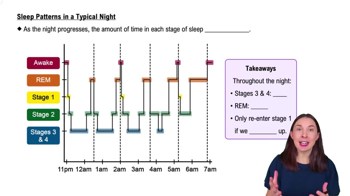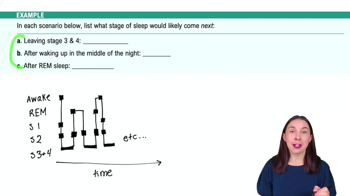Table of contents
- 1. Introduction to Psychology1h 43m
- 2. Psychology Research2h 20m
- 3. Biological Psychology2h 41m
- 4. Sensation and Perception28m
- 5. Consciousness and Sleep32m
- 6. Learning41m
- 7. Memory34m
- 8. Cognition37m
- 9. Emotion and Motivation35m
- 10. Developmental Psychology33m
- 11. Personality48m
- 12. Social Psychology41m
- 13. Stress and Health41m
- 14. Psychological Disorders44m
- 15. Treatment47m
5. Consciousness and Sleep
Sleep
Struggling with Psychology?
Join thousands of students who trust us to help them ace their exams!Watch the first videoMultiple Choice
Which of the following statements about REM sleep is true?
A
It is a much deeper, more restful kind of sleep than non-REM sleep.
B
It is the stage of sleep in which the heart beats the slowest.
C
It involves a lot of movement and thrashing as people have vivid dreams.
D
It is when 90 percent of dreams occur.
 Verified step by step guidance
Verified step by step guidance1
Understand the characteristics of REM sleep: REM (Rapid Eye Movement) sleep is a unique phase of sleep characterized by rapid movement of the eyes, low muscle tone, and vivid dreams.
Differentiate between REM and non-REM sleep: Non-REM sleep is generally considered to be deeper and more restful, whereas REM sleep is associated with increased brain activity and dreaming.
Consider physiological changes during REM sleep: During REM sleep, the heart rate can be irregular, and the body is typically in a state of atonia, meaning there is minimal movement.
Recognize the role of REM sleep in dreaming: REM sleep is the stage where the majority of dreaming occurs, with approximately 90% of dreams happening during this phase.
Evaluate the given statements: Compare each statement with the characteristics of REM sleep to determine which one accurately describes this sleep stage.

 3:25m
3:25mWatch next
Master Circadian Rhythms with a bite sized video explanation from Hannah Gordils
Start learningRelated Videos
Related Practice


































































































![Race, Genes and IQ Differences | Bret Weinstein [Mini Clip]](https://img.youtube.com/vi/IztL_m3pd70/mqdefault.jpg)



































































































